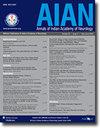Prevalence of Cognitive Impairment and Dementia After Intracerebral Hemorrhage
IF 1.9
4区 医学
Q3 CLINICAL NEUROLOGY
引用次数: 0
Abstract
To study the prevalence of cognitive impairment in survivors of intracerebral hemorrhage (ICH). Survivors of spontaneous ICH were followed up in the neurology outpatient department when they reported for follow-up after 6 months. Neuroimaging records at the onset and at follow-up visits are studied for the location of ICH, volume of ICH, intraventricular extension, and hydrocephalus. The volume of ICH is calculated by ABC/2 method on a CT scan. All patients underwent cognitive assessment with Addenbrooke’s cognitive examination ACE III and were categorized as patients having cognitive impairment (or) no cognitive impairment. A total of 120 patients were studied, out of which 77 (64%) are males and 43 (36%) are females with age groups ranging from 26 to 75 years. In the study population, the mean age was found to be 62.3 years. Specifically, the mean age for males was 56.9 years, while for females it was 63.4 years. Cognitive impairment was noted in 34 of 120 patients (28%) during 6 to 12 months of examination, of which 11 of 19 were in lobar location, 21 of 94 were in sub-cortical location, and 2 of 7 were in infratentorial location. It was found that 28% of survivors of ICH were cognitively impaired. Hence, it is essential to assess cognition in post-ICH patients during follow-up, so that suitable adjustments can be made in their employment, and also in educating family members in providing a good quality of life.脑出血后认知障碍和痴呆症的发病率
研究脑出血(ICH)幸存者认知障碍的发生率。 自发性 ICH 存活者在 6 个月后到神经内科门诊部复诊时接受随访。对发病时和随访时的神经影像记录进行研究,以了解 ICH 的位置、ICH 的体积、脑室内扩展和脑积水情况。ICH 容量是通过 CT 扫描的 ABC/2 方法计算得出的。所有患者都接受了 Addenbrooke's 认知检查 ACE III 的认知评估,并被分为有认知障碍(或)无认知障碍。 研究共涉及 120 名患者,其中男性 77 人(占 64%),女性 43 人(占 36%),年龄介于 26 岁至 75 岁之间。研究对象的平均年龄为 62.3 岁。其中,男性的平均年龄为 56.9 岁,女性为 63.4 岁。在 120 名患者中,有 34 人(28%)在 6 至 12 个月的检查期间出现认知障碍,其中 19 人中有 11 人出现在脑叶位置,94 人中有 21 人出现在皮层下位置,7 人中有 2 人出现在脑膜下位置。 研究发现,28% 的 ICH 幸存者认知能力受损。因此,有必要在随访过程中对脑损伤后患者的认知能力进行评估,以便对他们的工作进行适当调整,并教育家庭成员提供良好的生活质量。
本文章由计算机程序翻译,如有差异,请以英文原文为准。
求助全文
约1分钟内获得全文
求助全文
来源期刊

Annals of Indian Academy of Neurology
Nervous System Diseases-
CiteScore
2.20
自引率
11.80%
发文量
293
审稿时长
29 weeks
期刊介绍:
The journal has a clinical foundation and has been utilized most by clinical neurologists for improving the practice of neurology. While the focus is on neurology in India, the journal publishes manuscripts of high value from all parts of the world. Journal publishes reviews of various types, original articles, short communications, interesting images and case reports. The journal respects the scientific submission of its authors and believes in following an expeditious double-blind peer review process and endeavors to complete the review process within scheduled time frame. A significant effort from the author and the journal perhaps enables to strike an equilibrium to meet the professional expectations of the peers in the world of scientific publication. AIAN believes in safeguarding the privacy rights of human subjects. In order to comply with it, the journal instructs all authors when uploading the manuscript to also add the ethical clearance (human/animals)/ informed consent of subject in the manuscript. This applies to the study/case report that involves animal/human subjects/human specimens e.g. extracted tooth part/soft tissue for biopsy/in vitro analysis.
 求助内容:
求助内容: 应助结果提醒方式:
应助结果提醒方式:


